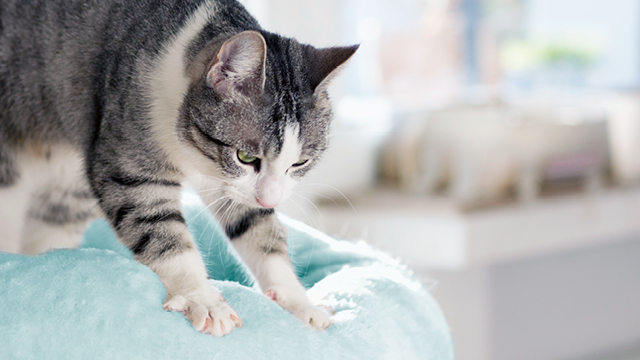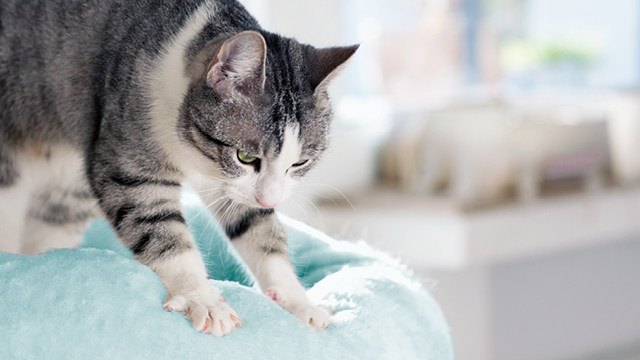
Written by Estelle Ferrari
The cat behaviors we all know and love can also be the biggest identifiers in helping diagnose an underlying issue our cat may have. That’s why it’s important to notice if something seems off with your beloved pet. Let’s take a look at these behaviors that can let you know when it’s time to consult a vet to help get your cat back to feeling their best.

The most common cat behaviors include purring, kneading, and grooming. These behaviors are also instrumental in us understanding the language of our cat. Typically, cats do these types of behaviors to their owners when they feel happy or content. However, when a cat is feeling sick, injured, or otherwise unwell, these types of behaviors will not be done as often if they were feeling healthy.
Purring
The most distinct sound a cat makes is purring. Worldwide, this sound is associated with happiness. It also means the cat is happy and content with their life. If your cat typically purrs a lot and suddenly stops or starts to purr too much, it could mean that something is wrong with them. Other than happiness, cats also purr excessively when they are sick or in pain. If you notice your cat has been purring too much or more than it normally does, you should consult your vet.
Appetite and Affection
Along with a lack of purring, loss of appetite, playfulness, and affection are other behaviors that you should take notice of. If your cat is sleeping more than it should, hiding away somewhere secluded, or not playing as much, those are all signs that they are ill.
When a cat is sick, they will usually sit in a hunched or crouching position and hide away somewhere (like under furniture or in boxes) and will either hide or sleep for most of the day. Other symptoms of an illness can include lack of affection when a cat is usually lovable, if he/she stops eating and begins to lose weight, and if they become lethargic and stops playing, especially if your cat is normally playful.
Dull Fur
Cats with dull fur is also another symptom of illness. If your cat’s fur is unkempt and not as shiny as it should be, that means your cat has not been grooming. Cats typically don’t groom when they’re sick because they’re too uncomfortable or too tired to tend to their fur. You can help your cat by brushing their fur to get them back into a habit of grooming, but only if their other symptoms begin to subside. Until then, your cat may still be too tired to want to groom their own fur.
Kneading
Kneading is another common cat behavior that is interpreted as a sign of affection. When cats knead their owners it usually means your cat trusts you. No one knows exactly why cats knead, but it is believed kneading signifies that a cat is relaxed and helps it feel less stressed. This is a habit this is first formed in childhood because kittens knead their mothers for milk. Cats who knead a lot and suddenly stop could mean that it might not be feeling well. It may not have enough energy, just like how a cat stops grooming its fur when it is sick.
Not doing any of these types of behaviors or doing an excessive amount of these behaviors are common signs that your cat is not feeling well. If it continues this for a long period of time, it is best to consult your vet.
Enjoy the article? Have some thoughts to share? Please leave us a comment below. We love to connect with fellow cat lovers!

